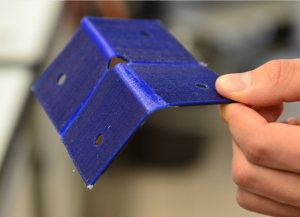An open earwig wing can expand 10 times larger than when it’s closed, which is one of the highest folding ratios in the entirety of the animal kingdom. The compact way it retracts lets the earwig tunnel underground without risk of harming its wings, and when the wing is in an open, locked state, it stays stiff without having to use muscle power for stability. The wing can then completely fold into itself with a single click, no muscular actuation necessary.
It’s no wonder that the team chose design principles that imitate the earwig’s wing to develop multifunctional, 3D printable origami structures. They have been studying the earwig’s elaborate wings by performing computer simulations, and developed an artificial structure which utilizes the same basic principle behind the wings.

The 3D printed imitation of the earwig wing can be folded as compact as its natural counterpart. [Image: ETH Zurich, Peter Rüegg]
“Once you’ve unfolded these things, it’s often impossible to fold them back to their original shape,” said Jakob A. Faber, with ETH Zurich’s Department of Materials. “If, on the other hand, they simply refolded automatically, this would save a lot of hassle.”
The researchers recently published a paper on their work, titled “Bioinspired spring origami,” in the Science journal; co-authors include Faber, Professor Andres F. Arrieta with the Programmable Structures Lab in the School of Mechanical Engineering at Purdue, and Professor André R. Studart, Professor for Complex Materials at ETH Zurich.
The abstract reads, “Origami enables folding of objects into a variety of shapes in arts, engineering, and biological systems. In contrast to well-known paper-folded objects, the wing of the earwig has an exquisite natural folding system that cannot be sufficiently described by current origami models. Such an unusual biological system displays incompatible folding patterns, remains open by a bistable locking mechanism during flight, and self-folds rapidly without muscular actuation. We show that these notable functionalities arise from the protein-rich joints of the earwig wing, which work as extensional and rotational springs between facets. Inspired by this biological wing, we establish a spring origami model that broadens the folding design space of traditional origami and allows for the fabrication of precisely tunable, four-dimensional–printed objects with programmable bioinspired morphing functionalities.”
Their simulations showed that if the earwig’s wing operated with the classic origami principle of using straight, rigid folds with an angular sum of 360° at the intersections, it could only fold down to a third of its size. The important thing to remember about the earwig’s wing is that the elastic folds are able to operate as either rotational or extensional springs, which goes beyond origami principle: some shapes just can’t be created using standard folds.
Sometimes, both rotational and extensional functions can be combined in the same joint. An earwig’s wing joints are formed from layers of resilin, an elastic biopolymer that determines the spring type from its thickness and arrangement.
Additionally, the researchers examined the central mid-wing joint of an earwig, which determines its stability in both closed and open states. The wing folds intersect at angles here, which do not match traditional origami theory.
Faber explained, “This point locks the wing in place in both its open and closed state.”
Once the findings from their computer simulations had been transferred to a multimaterial 3D printer, the team was able to manufacture a 4D printed object with four stiff, plastic plates, connected by a soft, elastic joint. The folds’ spring functions were actually programmed right into the material, so the object can mimic an earwig wing – which is stable when open but folds automatically if touched – by performing rotational or extensional movements.
The team used a membrane, which allows for variable stiffness and deformations, to replicate the folding of an earwig wing.
Then, the researchers transferred their design principle to an even bigger element and 3D printed a spring origami gripper, which can self-fold, lock, and grip objects without the use of external actuation.
At the moment, the 3D printed, self-folding origami elements are only prototypes. But I think I speak for campers everywhere when I say I’d love to see a self-folding tent based on these design principles someday.
Discuss this and other 3D printing topics at 3DPrintBoard.com or share your thoughts in the comments below.
[Source/Images: ETH Zurich]
Subscribe to Our Email Newsletter
Stay up-to-date on all the latest news from the 3D printing industry and receive information and offers from third party vendors.
You May Also Like
Precision at the Microscale: UK Researchers Advance Medical Devices with BMF’s 3D Printing Tech
University of Nottingham researchers are using Boston Micro Fabrication‘s (BMF) 3D printing technology to develop medical devices that improve compatibility with human tissue. Funded by a UK grant, this project...
3D Printing Webinar and Event Roundup: April 21, 2024
It’s another busy week of webinars and events, starting with Hannover Messe in Germany and continuing with Metalcasting Congress, Chinaplas, TechBlick’s Innovation Festival, and more. Stratasys continues its advanced training...
3D Printing Webinar and Event Roundup: March 17, 2024
It’s another busy week of webinars and events, including SALMED 2024 and AM Forum in Berlin. Stratasys continues its in-person training and is offering two webinars, ASTM is holding a...
3D Printed Micro Antenna is 15% Smaller and 6X Lighter
Horizon Microtechnologies has achieved success in creating a high-frequency D-Band horn antenna through micro 3D printing. However, this achievement did not rely solely on 3D printing; it involved a combination...



































